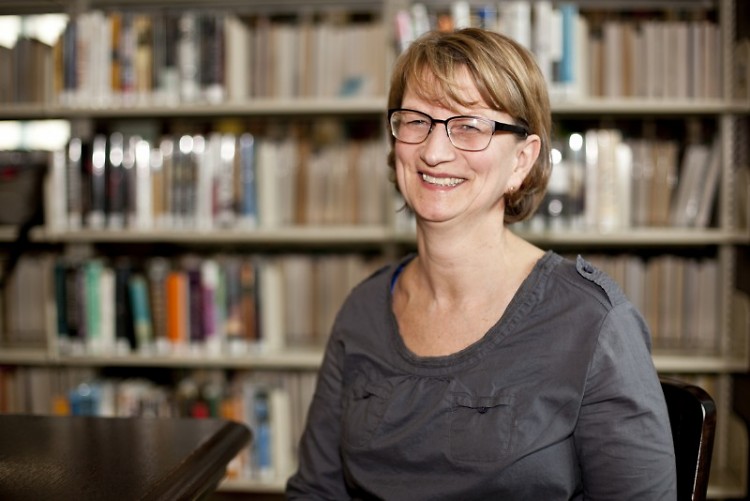“When I was in college I thought I was going to be a journalist. That’s what I aspired to,” says Carol Lautenbach, Assistant Superintendent of Teaching, Learning, and Accountability at Godfrey-Lee Schools. “Even when my kids were little, we’d write a neighborhood newsletter. I still have copies of it. [I did this with the kids] to bring the community together, to give the kids some idea of what was going on in the community, and how we could contribute to our little block.”
But she didn’t end up forging a career in the journalism field. Instead, she spent her life investing in education. Lautenbach says watching her own kids learn inspired her drive for education. She started with a teaching certificate, then a masters, then a doctorate in education. And along the way she started working in Godfrey-Lee Public Schools, where she’s now an Assistant Superintendent.
“I have done pretty much every job in every building in the district,” she says- while also admitting it’s a small district, just one square mile. But, she says, it’s growing. “Most are shrinking, we’re growing [at Godfrey-Lee]. It’s become a real magnet for families because of the small school atmosphere.”
It doesn’t take long to realize that for Lautenbach, education systems and communities are inextricably intertwined.
“Schools really depend on a community to support them, to form them, to inform them, to sustain them [and] to help them through change,” she says. “We have four kids. All four went to GRPS. It was a golden time for our family. They went to Congress Montessori [now a neighborhood school]. That school community was such a great model of how people can have similar commitment from vastly different perspectives. And it thrived. It was an amazingly vibrant little dot on the map.”
Her first visit to Congress Montessori solidified her connection between education and community.
“I observed three little kids. One had been doing rice pouring- that’s a big thing in Montessori,- and had spilled it everywhere. I mean, it was.. the floor was covered with it. He was probably 4. Instead of going to the teacher in distress, he grabbed two of his little classmates, they went to the closet and got the broom and the dustpan, and they cleaned it up. Completely on their own,” says Lautenbach. “Setting the community up for success is a huge part of any community. Somebody has a vision for what’s going to make this a productive place for humans to be, and I saw it on a very small scale with very small people working together really, really well.”
After living in the city for many years, Lautenbach and her husband moved out to Cascade Township for eight years.
“But we found that most of our time was being spent downtown: at church, at the GRAM, restaurants, all of those good places- and decided that we were going to invest fully by actually moving- relocating here. We toured the Fitz [Fitzgerald Residences], loved the idea of an old building being brought back to life and went for it," she says. "It’s idyllic. I wake up in the morning and I think, I can’t believe I live here."
Lautenbach says living downtown has transformed their lives, and opened up the possibilities of being involved.
“It’s just so much easier to be involved," she says. "We don’t have to think, well, are we going to go to that meeting down at the GRAM or not- well, yeah: we’re going to walk past it anyway.”
She has also seen her family open up to the possibilities of Grand Rapids through their residency downtown. Her oldest son's girlfriend, who grew up in Beijing, China and has traveled the world, visited for Christmas and proclaimed it was just what she had been looking for.
“She’s traveled all over the world, she knows what’s out there. And she really liked what Grand Rapids had to offer,” she says.
Lautenbach herself has learned more of what Grand Rapids has to offer through The Rapidian- and shares stories with friends and with the children and families in the Godfrey-Lee school district. She’s also had a chance to revisit her earlier dreams of journalism as a Rapidian reporter.
“One of the stories that I wrote was about our family’s involvement in the Fulton Street Farmers Market,” she says. “Relatives were reconnected again around that story- that’s what The Rapidian does. It takes that story that maybe is important to one person and makes it important to more people. And the more you can do that, the more you can connect with others, it’s like the Russian dolls. That’s what it feels like. There’s a small thing going on and it becomes something substantial and weighty because people know about it.”
Lautenbach discovered that she wasn’t just thrown on the website on her own.
“You get an editor and people who really care that it’s done well and done for an audience that will appreciate a very high standard of oversight,” she explains. “It reignited my interest in journalism again. It’s the vehicle for helping others know things that are important in our community.”
The Rapidian, a program of the 501(c)3 nonprofit Community Media Center, relies on the community’s support to help cover the cost of training reporters and publishing content.
We need your help.
If each of our readers and content creators who values this community platform help support its creation and maintenance, The Rapidian can continue to educate and facilitate a conversation around issues for years to come.
Please support The Rapidian and make a contribution today.

